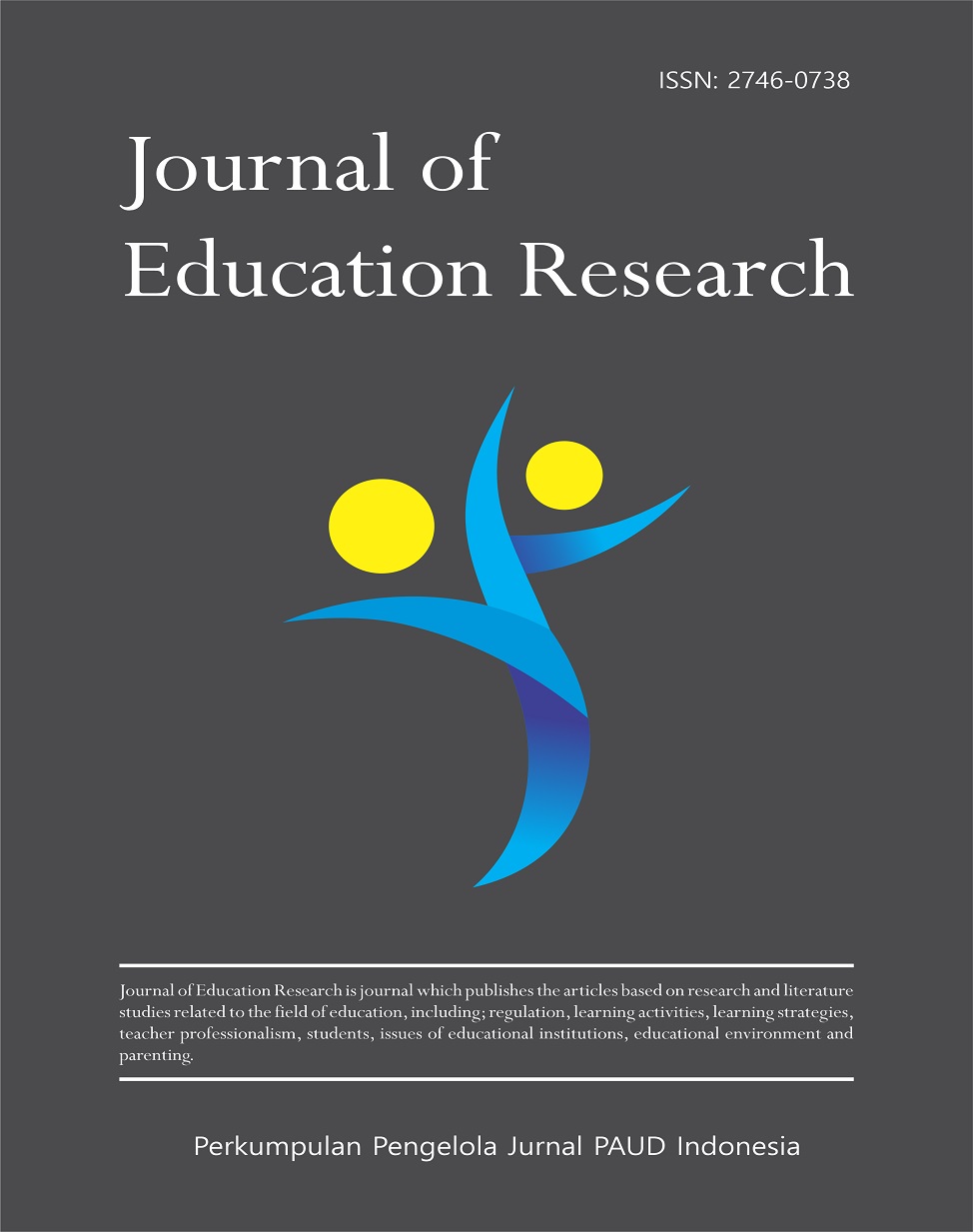Integrasi ChatGPT dan Baamboozle untuk Meningkatkan Pemahaman Konsep dan Motivasi Belajar Fisika
DOI:
https://doi.org/10.37985/jer.v6i3.2034Keywords:
Baamboozle, ChatGPT, Pemahaman konsep, Motivasi belajarAbstract
ASdf
Downloads
References
Ahmad, R. M. (2024). Efektivitas pelatihan integrasi Canva dan ChatGPT sebagai media pembelajaran bagi pendidik di Kota Kupang. Journal of Education Research, 5(2), 1081–1088. https://doi.org/10.37985/jer.v5i2.953
Amellia Kharis, A., & Zili, H. A. (2024). ChatGPT sebagai alat pendukung pembelajaran: Tantangan dan peluang pembelajaran abad 21. Paedagoria: Jurnal Kajian, Penelitian dan Pengembangan Kependidikan, 15(2), 206–214. http://journal.ummat.ac.id/index.php/paedagoria
Beltozar-Clemente, S., & Díaz-Vega, E. (2024). Physics XP: Integration of ChatGPT and gamification to improve academic performance and motivation in Physics 1 course. International Journal of Engineering Pedagogy, 14(6), 82–92. https://doi.org/10.3991/ijep.v14i6.47127
Bray, A., & Williams, J. (2020). Why is physics hard? Unpacking students’ perceptions of physics. Journal of Physics: Conference Series, 1512(1), 012002. https://doi.org/10.1088/1742-6596/1512/1/012002
Forero, M. G., & Herrera-Suárez, H. J. (2023). ChatGPT in the classroom: Boon or bane for physics students’ academic performance. arXiv. http://arxiv.org/abs/2312.02422
Hanum, S. A., Asrizal, A., & Festiyed, F. (2021). Analisis effect size pengaruh bahan ajar fisika dan IPA terpadu terhadap hasil belajar siswa. Jurnal Penelitian Pembelajaran Fisika, 7(2), 144. https://doi.org/10.24036/jppf.v7i2.111741
Hidayati, N. B., Zulkarnaen, & Darmadianingsih. (2022). Analisis motivasi belajar fisika pada peserta didik SMA Negeri 3 Samarinda. Seminar Nasional Pendidikan Profesi Guru, 42–46.
Juita. (2020). Identifikasi konsentrasi belajar siswa di sekolah menengah atas. Schrödinger: Journal of Physics Education (SJPE), 1(1), 24–29.
Kiraga, F. (2023). A study of problem solving in physics learning: A systematic review. EduFisika: Jurnal Pendidikan Fisika, 8(3), 303–315. https://doi.org/10.59052/edufisika.v8i3.29446
Mardiah, A., et al. (2024). The application of Baamboozle educational quiz in increasing. Jurnal Pendidikan, 12(2), 184–198.
Marwah, S., & Ain, Z. N. (2022). Studi literatur: Baamboozle sebagai media pembelajaran yang interaktif. Jurnal PGMI UNIGA, 69–75.
Muñoz, S. A. S., Gayoso, G. G., et al. (2023). Examining the impacts of ChatGPT on student motivation and engagement. Social Space: Przestzen Spoieczna, 23(1), 1–28.
Novita, P., Yusof, M. R., & Zaitun, Z. (2024). University students and ChatGPT: Redefining learning in the age of artificial intelligence. English Language in Focus (ELIF), 7(1), 19–30.
Nurhayati, N., Suliyem, M., Hanafi, I., & Susanto. (2024). Integrasi AI dalam collaborative learning untuk meningkatkan efektivitas pembelajaran. Academy of Education Journal, 15(1), 1063–1071. https://doi.org/10.47200/aoej.v15i1.2372
Nurmaliza, N., Meliza, W., et al. (2021). Deskripsi motivasi belajar fisika siswa kelas X SMA Negeri 3 Kota Sungai Penuh. Jurnal Sains dan Pendidikan Fisika, 17(1), 40. https://doi.org/10.35580/jspf.v17i1.15559
Nurzakiyah, N., Nurpahmi, S., & Damayanti, E. (2020). Hambatan guru fisika dalam menerapkan pembelajaran saintifik berbasis kurikulum 2013 di SMA. Jurnal Riset dan Kajian Pendidikan Fisika, 7(1), 1. https://doi.org/10.12928/jrkpf.v7i1.15664
Pietrocola, M. (2019). Upgrading physics education to meet the needs of society. https://doi.org/10.1007/978-3-319-96163-7
Puri, R. A., & Perdana, R. (2023). Analisis kemampuan pemahaman konsep fisika peserta didik SMA di Bantul pada materi fluida statis dan upaya peningkatannya melalui model pembelajaran visualization auditory kinesthetic. MAGNETON: Jurnal Inovasi Pembelajaran Fisika UNWIRA, 1(2), 93–101. https://doi.org/10.30822/magneton.v1i2.2463
Rahayu, I. R., & Rukmana, D. (2022). The effect of game-based learning model assisted by a Bamboozle on the multiplication operation skills of elementary school students. Primary: Jurnal Pendidikan Guru Sekolah Dasar, 11(4), 1265. https://doi.org/10.33578/jpfkip.v11i4.9000
Rizkita, N. I., & Mufit, F. (2022). Analisis pemahaman konsep dan sikap siswa terhadap belajar fisika pada materi hukum Newton tentang gerak. Jurnal Eksakta Pendidikan (JEP), 6(2), 233–242. https://doi.org/10.24036/jep/vol6-iss2/599
Rone, N. A., Amor, N., et al. (2023). Students’ lack of interest, motivation in learning, and classroom participation: How to motivate them? Psychology and Education: A Multidisciplinary Journal, 7(March), 585. https://doi.org/10.5281/zenodo.7749977
Sadriani, A., Ahmad, M. R. S., & Arifin, I. (2023). Peran guru dalam perkembangan teknologi pendidikan di era digital. Seminar Nasional Dies Natalis 62, 1, 32–37. https://doi.org/10.59562/semnasdies.v1i1.431
Santoso, A. (2020). Upaya peningkatan motivasi belajar fisika menggunakan model pembelajaran scramble. Jurnal Karya Ilmiah Guru, 5(2), 1–8.
Sasikala, P., & Ravichandran, R. (2024). Study on the impact of artificial intelligence on student learning outcomes. Journal of Digital Learning and Education, 4(2), 145–155. https://doi.org/10.52562/jdle.v4i2.1234
Suparmini, K., Suwindia, I. G., & Winangun, I. M. A. (2024). Gamifikasi untuk meningkatkan motivasi belajar siswa di era digital. Jurnal Pendidikan, 5(2), 145–148.
Tsurayya, N. A. (2023). Pemanfaatan media interaktif Baamboozle pada pembelajaran Bahasa Indonesia. Dinamika, 6(2), 81. https://doi.org/10.35194/jd.v6i2.3343
Ubaidillah, M., Hartono, Marwoto, P., et al. (2023). How to improve critical thinking in physics learning? A systematic literature review. Journal of Educational, Cultural and Psychological Studies, 2023(28). https://doi.org/10.7358/ecps-2023-028-ubai
Verawati, R. Y., Mastur, M., & Sufyadi, S. (2024). Peningkatan keterampilan kolaborasi melalui model Teams Games Tournament (TGT) berbantuan Baamboozle. Edukatif: Jurnal Ilmu Pendidikan, 6(3), 2128–2136. https://doi.org/10.31004/edukatif.v6i3.6591
Von Garrel, J., & Mayer, J. (2023). Artificial intelligence in studies—Use of ChatGPT and AI-based tools among students in Germany. Humanities and Social Sciences Communications, 10(1), 1–10. https://doi.org/10.1057/s41599-023-02304-7
Wang, Y. (2022). A comparative study on the effectiveness of traditional and modern teaching methods. In Proceedings of the 2022 5th International Conference on Humanities Education and Social Sciences (ICHESS 2022) (pp. 270–277). https://doi.org/10.2991/978-2-494069-89-3_32
Welbers, K., Konijn, E. A., et al. (2019). Gamification as a tool for engaging student learning: A field experiment with a gamified app. E-Learning and Digital Media, 16(2), 92–109. https://doi.org/10.1177/2042753018818342
Zhao, Z. (2023). The impact of ChatGPT on human society. Proceedings of the International Conference on Education, Language and Humanities, 1945–1951. https://doi.org/10.2991/978-2-38476-126-5_221
Downloads
Published
How to Cite
License
Copyright (c) 2025 Rabya Mulyawati Ahmad, Mauludin Satryawan Ahmad , Muh Amiruddin Salem

This work is licensed under a Creative Commons Attribution-ShareAlike 4.0 International License.
Authors who publish with this journal agree to the following terms:
- Authors retain copyright and grant the journal right of first publication with the work simultaneously licensed under a Creative Commons Attribution-ShareAlike 4.0 International License that allows others to share the work with an acknowledgement of the works authorship and initial publication in this journal.Â
- Authors are able to enter into separate, additional contractual arrangements for the non-exclusive distribution of the journals published version of the work (e.g., post it to an institutional repository or publish it in a book), with an acknowledgement of its initial publication in this journal.
- Authors are permitted and encouraged to post their work online (e.g., in institutional repositories or on their website) prior to and during the submission process, as it can lead to productive exchanges, as well as earlier and greater citation of published work (See The Effect of Open Access).









